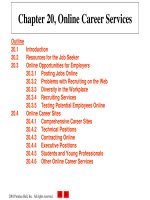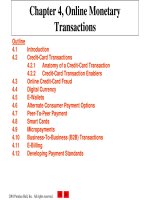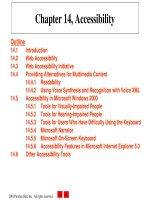Lecture E-commerce and e-business for managers - Chapter 11: Legal and ethical issues; internet taxation
Bạn đang xem bản rút gọn của tài liệu. Xem và tải ngay bản đầy đủ của tài liệu tại đây (757.94 KB, 44 trang )
Chapter 11, Legal and Ethical Issues;
Internet Taxation
Outline
11.1
Introduction
11.2
Legal Issues: Privacy on the Internet
11.2.1 Right to Privacy
11.2.2 Internet and the Right to Privacy
11.2.3 Network Advertising Initiative
11.2.4 Employer and Employee
11.2.5 Protecting Yourself as a User
11.2.6 Protecting Your Business: Privacy Issues
11.3
Legal Issues: Other Areas of Concern
11.3.1 Defamation
11.3.2 Sexually Explicit Speech
11.3.3 Children and the Internet
11.3.4 Alternative Methods of Regulation
11.3.5 Intellectual Property: Copyrights and Patents
11.3.6 Trademark and Domain Name Registration
2001 Prentice Hall, Inc. All rights reserved.
Chapter 11, Legal and Ethical Issues;
Internet Taxation
Outline
11.3.7 Unsolicited Commercial Email (Spam)
11.3.8 Online Auctions
11.3.9 Online Contracts
11.3.10 Online User Agreements
11.4
Cybercrime
11.5
Internet Taxation
2001 Prentice Hall, Inc. All rights reserved.
11.1 Introduction
• Real space
– Our physical environment consisting of temporal and
geographic boundaries
• Cyberspace
– The realm of digital transmission not limited by geography
2001 Prentice Hall, Inc. All rights reserved.
11.2 Legal Issues: Privacy on the
Internet
• Difficulty of applying traditional law to the
Internet
• Technology and the issue of privacy
2001 Prentice Hall, Inc. All rights reserved.
11.2.1 Right to Privacy
• Implicit in the First, Fourth, Ninth and Fourteenth
Amendments
• Olmstead vs. United States
– Telecommunication of alcohol sales during Prohibition era
– New application of the Fourth Amendment
• Translation
– Interpreting the Constitution to protect the greater good
2001 Prentice Hall, Inc. All rights reserved.
11.2.2 Internet and the Right to
Privacy
• Self-regulated medium
– The Internet industry governs itself
• Many Internet companies collect users’ personal
information
– Privacy advocates argue that these efforts violate
individuals’ privacy rights
– Online marketers and advertisers suggest that online
companies can better serve their users by recording the likes
and dislikes of online consumers
• Financial Services Modernization Act of 1999
– Establishes a set of regulations concerning the management
of consumer information
2001 Prentice Hall, Inc. All rights reserved.
11.2.3 Network Advertising Initiative
• Network Advertising Initiative (NAI)
– Approved by the FTC in July 1999 to support self regulation
• NAI currently represents 90 percent of Web
advertisers
• Determines the proper protocols for managing a
Web user’s personal information on the Internet
• Prohibits the collection of consumer data from
medical and financial sites
• Allows the combination of Webcollected data and
personal information
2001 Prentice Hall, Inc. All rights reserved.
11.2.3 DoubleClick: Marketing with
Personal Information Feature
• Regulation of the Internet could limit a company’s
efforts to buy and sell advertising
• DoubleClick
– Advertising network of over 1,500 sites and 11,000 clients
• Abacus Direct Corp
– Names, addresses, telephone numbers, age, gender, income
levels and a history of purchases at retail, catalog and online
stores
• Digital redlining
– Skewing of an individual’s knowledge of available products
by basing the advertisements the user sees on past behavior
2001 Prentice Hall, Inc. All rights reserved.
11.2.4 Employer and Employee
• Keystroke cop
– Registers each keystroke before it appears on the screen
• Company time and company equipment vs. the
rights of employees
• Determining factors
– Reasonable expectation of privacy
– Legitimate business interests
• Reasons for surveillance
– Slower transmission times
– Harassment suits
– Low productivity
2001 Prentice Hall, Inc. All rights reserved.
11.2.4 Employer and Employee
• Notice of Electronic Monitoring Act
– Proposed in 2000
– Would require employers to notify employees of telephone,
email and Internet surveillance
– Annual updates or when policy changes are made
– The frequency of surveillance, the type of information
collected and the method of collection would also be
disclosed
2001 Prentice Hall, Inc. All rights reserved.
11.2.4 Michael A. Smyth vs. The
Pillsbury Company Feature
• Dismissed as regional operations manager
• Questionable material in email
• Pennsylvania law
– “An employer may discharge an employee with or without
cause, at pleasure, unless restrained by some contract"
• Public policy
– Reprimanding an employee called for jury duty
– Denial of employment as a result of previous convictions
• Verdict awarded to Pillsbury
– No reasonable expectation of privacy
– Legitimate business interests
2001 Prentice Hall, Inc. All rights reserved.
11.2.5 Protecting Yourself as a User
• Anonimity and pseudonimity
– PrivacyX.com
• Platform for Privacy Preferences Project (P3P)
– Browser complies in accordance with users’ privacy
preferences by allowing them to interact in specific ways
• Privacy services and software
– Junkbusters.com
– PrivacyChoices.org
– Center for Democracy and Technology
– Electronic Frontier Foundation
– Electronic Privacy Information Center
– PrivacyRights. org
2001 Prentice Hall, Inc. All rights reserved.
11.2.6 Protecting Your Business:
Privacy Issues
• Privacy policy
– The stated policy regarding the collection and use of
visitor’s personal information
• Privacy policy services and software
– PrivacyBot.com
– TRUSTe
2001 Prentice Hall, Inc. All rights reserved.
11.2.6 Protecting Your Business:
Privacy Issues
• Core Fair Information Practices
– Consumers should be made aware that personal information
will be collected
– The consumer should have a say in how this information will
be used
– The consumer should have the ability to check the
information collected to ensure that it is complete and
accurate
– The information collected should be secured
– The Web site should be responsible for seeing that these
practices are followed
2001 Prentice Hall, Inc. All rights reserved.
11.2.6 Protecting Your Business:
Privacy Issues
PrivacyBot.com. (Courtesy of Invisible Hand Software, LLC.)
2001 Prentice Hall, Inc. All rights reserved.
11.3 Legal Issues: Other Areas of
Concern
•
•
•
•
•
•
Defamation
Sexually explicit speech
Copyright and patents
Trademarks
Unsolicited e-mail
First Amendment
– "Congress shall make no law respecting an establishment of
religion, or prohibiting the free exercise thereof; or
abridging the freedom of speech, or of the press; or the right
of the people peaceably to assemble and to petition the
Government for a redress of grievances"
2001 Prentice Hall, Inc. All rights reserved.
11.3.1 Defamation
• Defamation
– The act of injuring another’s reputation, honor or good name
through false written or oral communication
• Libel
– Defamatory statements written or spoken in a context in
which they have longevity and pervasiveness that exceed
slander
2001 Prentice Hall, Inc. All rights reserved.
11.3.1 Defamation
• Slander
– Spoken defamation
• Proving defamation
– The statement must have been published, spoken or
broadcast
– There must be identification of the individual(s) through
name or reasonable association
– The statement must be defamatory
– There must be fault
– There must be evidence of injury
2001 Prentice Hall, Inc. All rights reserved.
11.3.1 Defamation
• Good Samaritan provision, Section 230 of the
Telecommunications Act
– Protects ISPs from defamation lawsuits when the ISPs’
attempt to control potentially damaging postings
– “Obscene, lewd, lascivious, filthy, excessively violent,
harassing or otherwise objectionable"
2001 Prentice Hall, Inc. All rights reserved.
11.3.1 Cubby vs. Compuserve and
Stratton Oakmont vs. Prodigy Feature
• Cubby vs. Compuserve
– Anonymous individual used a news service hosted by
Compuserve to post an allegedly defamatory statement
• Distributor vs. publisher
– A distributor cannot be held liable for a defamatory
statement unless the distributor has knowledge of the content
– Compuserve was a distributor of content
• Stratton Oakmont vs. Prodigy
– Claimed responsibility to remove potentially defamatory or
otherwise questionable material
– Prodigy served as a publisher of the content
2001 Prentice Hall, Inc. All rights reserved.
11.3.2 Sexually Explicit Speech
• Miller vs. California (1973)
– The Miller Test identifies the criteria used to distinguish
between obscenity and pornography
– Must appeal to the prurient interest, according to
contemporary community standards
– When taken as a whole, lacks serious literary, artistic,
political or scientific value
• Challenge of community standards in cyberspace
2001 Prentice Hall, Inc. All rights reserved.
11.3.2 United States vs. Thomas
Feature
• Thomas
– Internet business owner in California, owner of pornographic
Web site from which merchandise could be ordered
– Accessible by password
– Acceptable by California community standards
– Sold pornographic material to Tennessee resident (opposing
community standards)
• Thomas found guilty
• Noncontent related means
– Effort to control the audience rather than controlling the
material
2001 Prentice Hall, Inc. All rights reserved.
11.3.3 Children and the Internet
• Accessibility of information
• Decency Act of 1996 (CDA) and Children’s
Online Protection Act of 1998 (COPA)
– Designed to restrict pornography on the Internet, particularly
in the interest of children
– Overbroad
– “Patently offensive,” “indecent” and “harmful to minors”
• Chilling effect
– Limiting speech to avoid a lawsuit
• Children’s Online Privacy Protection Act of 2000
(COPPA)
– Prohibits Web sites from collecting personal information
from children under the age of 13
2001 Prentice Hall, Inc. All rights reserved.
11.3.4 Alternatives Methods of
Regulation
• Blocking and filtering
– Allows users to select what kinds of information can and
cannot be received through their browsers
• Blocking and filtering software and services
– Surfwatch.com
– Cybersitter.com
– NetNanny.com
• Infringement of First Amendment rights
• Parent’s counsel
– CyberAngels.com
– GetNetWise.com
– Parentsoup.com
2001 Prentice Hall, Inc. All rights reserved.
11.3.4 Alternatives Methods of
Regulation
Net Nanny home page. (Courtesy of Net Nanny Software
International, Inc.)
2001 Prentice Hall, Inc. All rights reserved.









